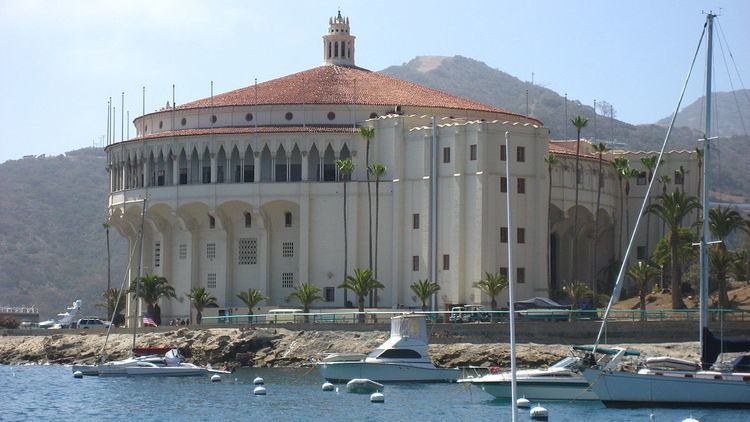Country United States Cost 2 million USD Construction started February 1928 | Opened 1927 Phone +1 310-510-0179 | |
 | ||
Owner Santa Catalina Island Company Similar Casino Ballroom, Wrigley Botanical Gardens, Catalina Island Museum, Avalon Theatre, SS Catalina | ||
Catalina casino tour 2012 hd
The Catalina Casino is located in Avalon on Santa Catalina Island, off the coast of Los Angeles in California. It is the most visible landmark in Avalon Bay, and when approaching it from the mainland.
Contents
- Catalina casino tour 2012 hd
- Catalina casino avalon casino
- History
- Structure
- Movie theater
- Ballroom
- Catalina Island Museum
- References
The large building contains a movie theatre, ballroom, and island art and history museum. The Catalina Casino gets its name from the Italian language term casino, meaning a "gathering place." There is no gambling at the facility.
Catalina casino avalon casino
History
The Catalina Casino was built on a site formerly known as Sugarloaf Point. The site was graded for the planned construction of the Hotel St. Catherine. However, it was eventually built in Descanso Canyon instead. When chewing gum magnate William Wrigley Jr. bought the controlling stake in Catalina Island in 1919, he used this cleared site to build a dance hall he named Sugarloaf Casino. It served as a ballroom and Avalon's first high school, until it became too small for Avalon's growing population. In 1928, the Sugarloaf was razed to make room for a newer casino building. Sugarloaf Rock was further blasted away to enhance the Casino's ocean view.
On May 29, 1929, the new Catalina Casino was completed under the direction of Wrigley and David M. Renton, at a cost of 2 million dollars. Its design, by Sumner Spaulding and Walter Weber, is in the Art Deco and Mediterranean Revival styles. It was the first movie theatre to be designed specifically for films with sound ("talkies"). It received the Honor Award from the California Chapter of the American Institute of Architects, as "one of the outstanding architectural accomplishments."
With a height equal to a 12-story building, it was built to serve as a theatre on the main floor and a ballroom and promenade on the upper level. Movie studio tycoons such as Cecil B. DeMille, Louis B. Mayer, and Samuel Goldwyn frequently came by yacht to the Casino to preview their newest cinema productions. It also serves as the island's civil defense shelter, large enough to accommodate Catalina's entire year-round population. Within its walls is stored enough food and water for all Avalon's residents for two weeks.
The steel structure of the predecessor Sugarloaf Casino can still be found in Avalon's abandoned bird park. The bird park was conceived by Mrs. Wrigley in the 1930s, and at the time it was one of the largest aviaries in the world.
In 1993 the movie theater was photographed by Hiroshi Sugimoto, for his art series "Theatres."
In September 2008, the Catalina Casino had the first live full production of a musical on its stage, when the Santa Catalina Island Company presented Grease!.
Structure
Surrounded by sea on three sides, the circular structure of the Catalina Casino is the equivalent of 12 stories tall. It has a movie theatre and the Catalina Island Museum on the first level, and a ballroom on the top level. The building interiors were decorated in the Art Deco style, including with sterling silver and gold leaf accents.
Movie theater
The Avalon Theater is a movie theater on the first level, with a seating capacity of 1,154. It has a single massive screen, and still shows first run movies. The theater has its original 4-manual, 16 rank pipe organ built by the Page Organ Company of Lima, Ohio.
The theatre is sound insulated so that patrons do not hear the band or up to 3,000 dancers in the ballroom above. The circular domed ceiling has notable acoustics and has been studied by acoustical designers, due to its repute. A speaker on the theatre stage can speak in a normal voice without a microphone, and be heard clearly by all in attendance.
The theater's interior walls retain the original Art Deco murals by John Gabriel Beckman. The theater's facade had a painted mural of an Art Deco style underwater world scene, which was later replaced with replications of Beckman's design created in Catalina Pottery style tiles. The lobby has walnut wood paneling.
Ballroom
The upper level houses the 20,000 square foot Catalina Casino Ballroom. It is the world's largest circular ballroom with a 180-foot (55 m) diameter dance floor, that can accommodate 3,000 dancers. French doors encircle the room connecting the dance floor with the "Romance Promenade," an open balcony that runs around the building.
To reach the ballroom on the top level the Casino building has two ramped walkways, both in enclosed towers that extend out from the circular building. Wrigley took the idea to use ramps instead of stairs from Wrigley Field, his Chicago Cubs stadium. The ramps allowed the large numbers of people using the ballroom to quickly move to and from their destinations. They each have a small lobby areas just below the dance floor level.
Catalina Island Museum
In 1953 Philip K. Wrigley established the Catalina Island Museum on the first level, to preserve the history of the island from the Pre-Columbian indigenous Island Tongva (Gabrielino) peoples through the pre-war 20th century development by his father. The museum features a large and comprehensive collection of original Catalina Pottery ceramics, produced by Catalina Clay Products between 1927 and 1937.
The museum continues documenting Catalina Island history, adding from World War II to the present day and a research institute. It is the repository for all archeological digs on the island, and has one of the largest collections of Island Tongva artifacts in the world. There are now over 10,000 photographs and negatives documenting island life from the early 1880s until the present day in the museum's photography collection.
